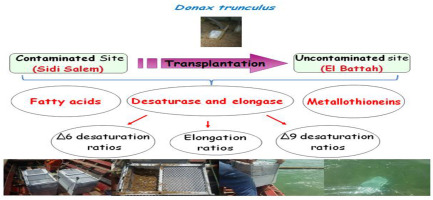Environmental Pollution ( IF 8.9 ) Pub Date : 2018-02-15 , DOI: 10.1016/j.envpol.2018.01.041 Amina Rabei , Aziz Hichami , Hayet Beldi , Sandrine Bellenger , Naim Akhtar Khan , Noureddine Soltani

|
The gulf of Annaba, the most important touristic and economic coastal zone located in Northeast Algeria, is contaminated by several pollutants from urban, agricultural, harbor and industrial activities. Elevated levels of heavy metals were detected in a locally prevalent edible mollusk Donax trunculus (Bivalvia, Donacidae) widely used as a sentinel species for the assessment of marine pollution. The present work aims to measure the difference between two localities, one being full of different pollutants (Sidi Salem) and the other being relatively clean (El Battah) and to evaluate the ability of D. trunculus to overcome the environmental stress during a transplantation experiment by a determination of fatty acid profile, the enzymes activities and the level of metallothioneins (MTs), a biomarker of metallic contamination. Adults of D. trunculus were collected at Sidi Salem (contaminated site) and transplanted into El Battah (reference site) for 21 days in cages (60 × 60 × 60 cm with a 2 mm mesh). Biochemical analyzes were conducted at different times (0, 7, 14 and 21 days). At 0-day experiment: the rate of the fatty acids, the enzymes activities and MT levels at the site of Sidi Salem (polluted site) were significantly different from those of El Battah. During the transplantation a gradual restoration of fatty acids rates, enzymes activities and MT levels was observed. At the end of the period of transplantation, the values are comparable to those of El Battah. A two-way ANOVA (time, site) on data revealed significant effects of time and site. Overally, D. trunculus is able to induce its detoxification system and to restore relatively rapidly the status of individuals from the reference site (El Battah).
中文翻译:

来自安纳巴湾(阿尔及利亚)受污染和参考点的杜鹃(Mollusca,双壳维亚)中的脂肪酸组成,酶活性和金属硫蛋白:移植过程中的恢复模式
安纳巴湾是阿尔及利亚东北部最重要的旅游和经济沿海地区,被城市,农业,港口和工业活动中的几种污染物污染。在当地普遍食用的软体动物唐氏t(Bivalvia,Donacidae)中检测到重金属含量升高,该widely被广泛用作评估海洋污染的定点物种。当前的工作旨在测量两个地区之间的差异,一个地区充满了不同的污染物(西迪·塞勒姆),另一个地区则相对较清洁(El Battah),并评估了run藜的能力。通过确定脂肪酸谱,酶活性和金属硫蛋白(MTs)的水平来克服移植实验过程中的环境压力,金属硫蛋白是金属污染的生物标记。成虫D. trunculus在Sidi Salem(受污染的地点)收集并在笼子(60×60×60 cm,2 mm网孔)中移植到El Battah(参考地点)中21天。在不同的时间(0、7、14和21天)进行生化分析。在第0天的实验中:Sidi Salem站点(受污染的站点)的脂肪酸,酶活性和MT含量的比率与El Battah显着不同。在移植过程中,观察到脂肪酸速率,酶活性和MT水平逐渐恢复。在移植期结束时,该值可与El Battah的值相媲美。对数据的双向方差分析(时间,地点)揭示了时间和地点的显着影响。总体而言,D。trunculus 能够诱导其排毒系统,并从参考位点(El Battah)相对快速地恢复个体的状态。



























 京公网安备 11010802027423号
京公网安备 11010802027423号